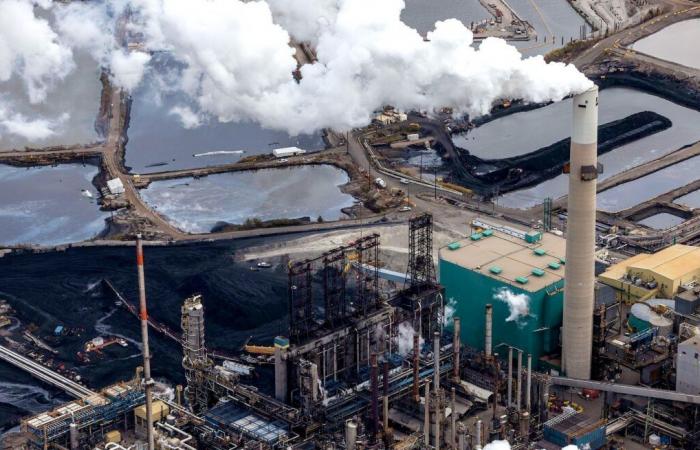The use of fossil fuels exported by Canada has generated more than 10 billion tonnes of greenhouse gases since 2012, reveal data from the federal Ministry of the Environment. Not only do the emissions produced each year by the combustion of these resources now exceed the Canadian national balance, but they are expected to continue to increase.
According to data compiled by Environment and Climate Change Canada (ECCC), greenhouse gas (GHG) emissions linked to the “burning” of exported oil, gas and coal totaled more than 10 billion tonnes between 2012. and 2023.
They have also been essentially growing year after year, to exceed one billion tonnes in 2023, the largest share going to crude oil (764 million tonnes). And from 2012 to 2023, annual emissions associated with exports increased by 58%.
These figures, which are obviously not part of Canada’s official GHG report, were transmitted by ECCC at the request of the organizations Ecojustice and Environmental Defense.
In particular, they show that the annual carbon footprint of Canada’s fossil fuel exports has exceeded the country’s official national footprint since 2016. For example, in 2022, the official balance was 708 million tonnes, including 216 million tonnes for “oil and gas exploitation”. The balance linked to the use of exported oil, gas and coal amounted to 990 million tonnes that same year.
Executive Director of the Climate Action Network Canada, Caroline Brouillette considers it “alarming” to see such growth in emissions, while Canada is striving to reduce its national balance sheet. “It is of course important to reduce our national emissions, but the climate does not care where fossil fuels are burned. »
“The data clearly shows us that part of economic growth in Canada depends on the export of greenhouse gases. It’s problematic from a climate point of view,” summarizes Éric Pineault, member of the Research Chair on Ecological Transition at the UQAM Institute of Management Sciences.
Mr. Pineault recalls at the same time that the federal government has offered significant support to facilitate industry exports, notably by purchasing and financing the expansion of the Trans Mountain pipeline network, but also by approving natural gas projects. liquefied on the Canadian west coast.
Researcher at the Institute for Socioeconomic Research and Information, Colin Pratte adds that Ottawa has injected more than $12 billion for the development of carbon capture and storage technologies which are at the heart of the companies’ strategy to ” green” their GHG balance in the country, while GHGs are increasing outside our borders.
Continued growth
Furthermore, in announcing the details of its regulatory project to cap emissions from oil and gas exploitation last week, the Trudeau government took care to repeat that the “continued growth in production” would continue to reach 16 % by 2030, compared to 2019.
The federal government sees this future growth as a way to “meet global demand”. Canada currently ranks as the world’s third largest exporter of crude oil and sixth largest exporter of natural gas.
The industry expects growth in production and exports for several more years, still focusing on their main market, the United States. The arrival of Donald Trump is also good news for businesses, according to Mark Purdon, professor at the School of Management Sciences at UQAM.
The carbon footprint of exported fossil resources should therefore continue to increase, deplore Ecojustice and Environmental Defense. “The growth of export emissions reduces Canada’s credibility as a climate leader and ignores our responsibility to align our actions with a sustainable climate in the future,” according to Reid Gomme, spokesperson for Ecojustice.
The latter judges that the country and the producing provinces should on the contrary provide their share of efforts to reduce the production of the resources which fuel the climate crisis.
Same story with Julia Levin, specialist in climate issues at Environmental Defense. She recalls that the countries meeting last year at the United Nations Conference on Climate Change (COP28), including Canada, agreed to implement a “transition” away from fossil fuels, in order to keep the world alive. idea of limiting climate disruption to a viable threshold.
However, the warming of 1.5°C compared to the pre-industrial era should be exceeded in less than 10 years. To hope to respect this commitment included in the Paris Agreement, we would have to cap global GHG emissions by 2025, at the latest, then reduce them by 43% by 2030, compared to the 2019 level.
Several scientists, but also the Secretary General of the United Nations, António Guterres, believe that to slow global warming, we will have to quickly get rid of our dependence on oil, gas and coal. “Science indicates that limiting global warming to 1.5 degrees will be impossible without the gradual elimination of all fossil fuels within a time frame compatible with this limit,” underlined Mr. Guterres after COP28. “The era of fossil fuels must end. »
In interview at Duty last Sunday, the federal Minister of the Environment, Steven Guilbeault, explained that greenhouse gas emissions are counted where energy is consumed.






